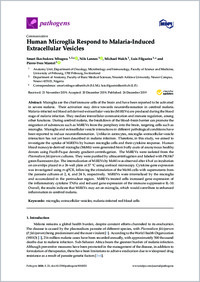Human microglia respond to malaria-induced extracellular vesicles
- Mbagwu, Smart Ikechukwu Anatomy Unit, Department of Oncology, Microbiology and Immunology, Faculty of Science and Medicine, University of Fribourg, Switzerland - Department of Anatomy, Faculty of Basic Medical Sciences, Nnamdi Azikiwe University, Nnewi, Nigeria
- Lannes, Nils Anatomy Unit, Department of Oncology, Microbiology and Immunology, Faculty of Science and Medicine, University of Fribourg, Switzerland
- Walch, Michael Anatomy Unit, Department of Oncology, Microbiology and Immunology, Faculty of Science and Medicine, University of Fribourg, Switzerland
- Filgueira, Luis Anatomy Unit, Department of Oncology, Microbiology and Immunology, Faculty of Science and Medicine, University of Fribourg, Switzerland
- Mantel, Pierre-Yves Anatomy Unit, Department of Oncology, Microbiology and Immunology, Faculty of Science and Medicine, University of Fribourg, Switzerland
-
24.12.2019
Published in:
- Pathogens. - 2020, vol. 9, no. 1, p. 21
English
Microglia are the chief immune cells of the brain and have been reported to be activated in severe malaria. Their activation may drive towards neuroinflammation in cerebral malaria. Malaria-infected red blood cell derived-extracellular vesicles (MiREVs) are produced during the blood stage of malaria infection. They mediate intercellular communication and immune regulation, among other functions. During cerebral malaria, the breakdown of the bloodbrain barrier can promote the migration of substances such as MiREVs from the periphery into the brain, targeting cells such as microglia. Microglia and extracellular vesicle interactions in different pathological conditions have been reported to induce neuroinflammation. Unlike in astrocytes, microgliaextracellular vesicle interaction has not yet been described in malaria infection. Therefore, in this study, we aimed to investigate the uptake of MiREVs by human microglia cells and their cytokine response. Human blood monocyte-derived microglia (MoMi) were generated from buffy coats of anonymous healthy donors using Ficoll-Paque density gradient centrifugation. The MiREVs were isolated from the Plasmodium falciparum cultures. They were purified by ultracentrifugation and labeled with PKH67 green fluorescent dye. The internalization of MiREVs by MoMi was observed after 4 h of co-incubation on coverslips placed in a 24-well plate at 37 C using confocal microscopy. Cytokine-gene expression was investigated using rt- qPCR, following the stimulation of the MoMi cells with supernatants from the parasite cultures at 2, 4, and 24 h, respectively. MiREVs were internalized by the microglia and accumulated in the perinuclear region. MiREVs-treated cells increased gene expression of the inflammatory cytokine TNF and reduced gene expression of the immune suppressive IL-10. Overall, the results indicate that MiREVs may act on microglia, which would contribute to enhanced inflammation in cerebral malaria.
- Faculty
- Faculté des sciences et de médecine
- Department
- Département de Médecine
- Language
-
- English
- Classification
- Biological sciences
- License
-
License undefined
- Identifiers
-
- RERO DOC 328217
- DOI 10.3390/pathogens9010021
- Persistent URL
- https://folia.unifr.ch/unifr/documents/308559
Statistics
Document views: 106
File downloads:
- pdf: 264
